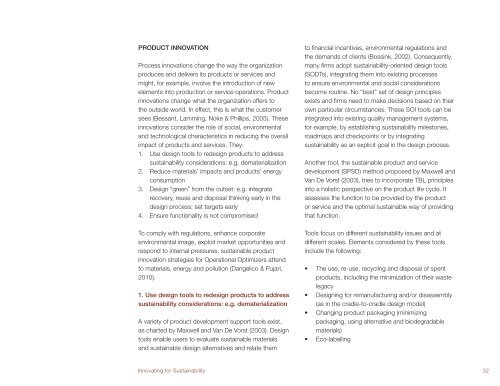Systematic Review - Network for Business Sustainability
Systematic Review - Network for Business Sustainability
Systematic Review - Network for Business Sustainability
You also want an ePaper? Increase the reach of your titles
YUMPU automatically turns print PDFs into web optimized ePapers that Google loves.
PRODUCT INNOVATION<br />
Process innovations change the way the organization<br />
produces and delivers its products or services and<br />
might, <strong>for</strong> example, involve the introduction of new<br />
elements into production or service operations. Product<br />
innovations change what the organization offers to<br />
the outside world. In effect, this is what the customer<br />
sees (Bessant, Lamming, Noke & Phillips, 2005). These<br />
innovations consider the role of social, environmental<br />
and technological characteristics in reducing the overall<br />
impact of products and services. They:<br />
1. Use design tools to redesign products to address<br />
sustainability considerations: e.g. dematerialization<br />
2. Reduce materials’ impacts and products’ energy<br />
consumption<br />
3. Design “green” from the outset: e.g. integrate<br />
recovery, reuse and disposal thinking early in the<br />
design process; set targets early<br />
4. Ensure functionality is not compromised<br />
To comply with regulations, enhance corporate<br />
environmental image, exploit market opportunities and<br />
respond to internal pressures, sustainable product<br />
innovation strategies <strong>for</strong> Operational Optimizers attend<br />
to materials, energy and pollution (Dangelico & Pujari,<br />
2010).<br />
1. Use design tools to redesign products to address<br />
sustainability considerations: e.g. dematerialization<br />
A variety of product development support tools exist,<br />
as charted by Maxwell and Van De Vorst (2003). Design<br />
tools enable users to evaluate sustainable materials<br />
and sustainable design alternatives and relate them<br />
to financial incentives, environmental regulations and<br />
the demands of clients (Bossink, 2002). Consequently,<br />
many firms adopt sustainability-oriented design tools<br />
(SODTs), integrating them into existing processes<br />
to ensure environmental and social considerations<br />
become routine. No “best” set of design principles<br />
exists and firms need to make decisions based on their<br />
own particular circumstances. These SOI tools can be<br />
integrated into existing quality management systems,<br />
<strong>for</strong> example, by establishing sustainability milestones,<br />
roadmaps and checkpoints or by integrating<br />
sustainability as an explicit goal in the design process.<br />
Another tool, the sustainable product and service<br />
development (SPSD) method proposed by Maxwell and<br />
Van De Vorst (2003), tries to incorporate TBL principles<br />
into a holistic perspective on the product life cycle. It<br />
assesses the function to be provided by the product<br />
or service and the optimal sustainable way of providing<br />
that function.<br />
Tools focus on different sustainability issues and at<br />
different scales. Elements considered by these tools<br />
include the following:<br />
• The use, re-use, recycling and disposal of spent<br />
products, including the minimization of their waste<br />
legacy<br />
• Designing <strong>for</strong> remanufacturing and/or disassembly<br />
(as in the cradle-to-cradle design model)<br />
• Changing product packaging (minimizing<br />
packaging, using alternative and biodegradable<br />
materials)<br />
• Eco-labelling<br />
Innovating <strong>for</strong> <strong>Sustainability</strong> 32
















